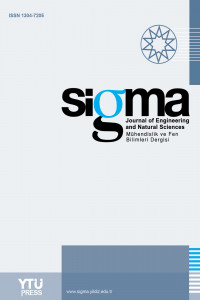Abstract
The aim of this study is the development of a hybrid pattern for 3D printed object via Fused Deposition Modeling Technique (FDM). In the previous study, a tensile test simulation was applied to the specimens with linear, hexagonal and diamond infill patterns. These patterns were designed with 50% infill density. Nodal displacement was applied as 0.04 mm to specimens as 8 steps to create realistic tensile test simulation. For comparison; the key parameters for structural strength and pattern influence were obtained from the simulation results. Tensile test simulation showed that hexagonal pattern has the lowest degree of occurred stress values and provides highest factor of safety for 50% infill density, when compared with the other type of pattern types.
An optimization process was conducted in this study to gain better results for 3D printing by considering the parameters of manufacturing time, material consumption and structural strength. In optimization process, the tensile test simulation results of the specimens with different patterns were taken into consideration. The stress raiser zones (stress concentration) show the maximum occurred stress. They were reinforced with the hexagonal pattern. Clamped section and straight zones were designed with the pattern type of diamond for optimization. The pattern of the hybrid system was created with 64% of diamond and 36% of hexagonal. Structural analyses were applied to designed specimens with hexagonal, diamond and hybrid types of infill patterns.
The results showed that manufacturing time and material consumption increased 2 minutes and 0.2 g respectively. 12 % strength and more ductile structure were obtained with hybrid pattern. Therefore, it can be concluded that the developed hybrid pattern is optimum for 3D Printing Technology.
References
- [1] Standard Terminology for Additive Manufacturing. General Principles Terminology. ISO/ ASTM52900-15.Vol. 10.04.
- [2] Bikas, H., Stavropoulos, P.,Chryssolouris, G,2016, “Additive manufacturing methods and modeling approaches: a critical review”, The International Journal of Advanced Manufacturing Technology.2016;83(1-4), 389-405.
- [3] Wohlers TT Wohlers report, 2016, “Additive manufacturing and 3D printing state of the industry: annual worldwide progress report”, Fort Collins, Wohlers Associates.
- [4] Wohlers, T.T. Wohlers Report 2011, “Additive Manufacturing and 3D Printing State of the Industry Annual Worldwide Progress Report”, Wohlers Associates, Inc., Fort Collins, CO.
- [5] Pham, D., Dimov, S. S., 2012, “Rapid manufacturing the technologies and applications of rapid prototyping and rapid tooling”, Springer Science & Business Media.
- [6] N. Turner, B., Strong, R., A. Gold, S.,2014, “A review of melt extrusion additive manufacturing processes: I. Process design and modeling”, Rapid Prototyping Journal;20(3), 192-204.
- [7] Woesz, A.,2008, “Rapid prototyping to produce porous scaffolds with controlled architecture for possible use in bone tissue engineering”,In Virtual Prototyping & Bio Manufacturing in Medical Applications; pp. 171-206. Springer, Boston, MA.
- [8] Baumann, F. W., Roller, 2017, “Additive Manufacturing, Cloud-Based 3D Printing and Associated Services Overview”, Journal of Manufacturing and Materials Processing;1(2), 15.
- [9] Kruth, J. P.,1991 “Material incress manufacturing by rapid prototyping techniques”, CIRP Annals-Manufacturing Technology; 40(2), 603-614.
- [10] Cesarano J, King B.H, Denham H.B, 1991, Recent developments in robocasting of ceramics and multimaterial deposition, Proceedings of the 9th Solid FeeeformFabricatuion Symposium; pp 697–704.
Details
| Primary Language | English |
|---|---|
| Subjects | Engineering |
| Journal Section | Research Articles |
| Authors | |
| Publication Date | September 1, 2018 |
| Submission Date | May 8, 2018 |
| Published in Issue | Year 2018 Volume: 36 Issue: 3 |
IMPORTANT NOTE: JOURNAL SUBMISSION LINK https://eds.yildiz.edu.tr/sigma/


